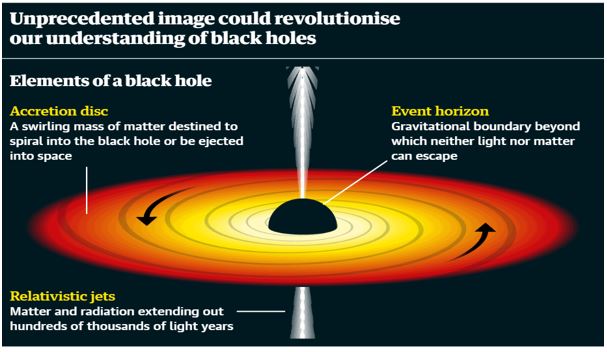ForumIAS announcing GS Foundation Program for UPSC CSE 2025-26 from 19 April. Click Here for more information.
ForumIAS Answer Writing Focus Group (AWFG) for Mains 2024 commencing from 24th June 2024. The Entrance Test for the program will be held on 28th April 2024 at 9 AM. To know more about the program visit: https://forumias.com/blog/awfg2024
Read In-depth analysis of all the Editorials here
Context
The Event Horizon Telescope (EHT), which uses a network of telescopes around the globe to turn the Earth into an enormous radio telescope, has taken the first direct image of a black hole. This image shows the large black hole in the centre of another galaxy called galaxy Messier 87, which is 55 million light years away.
About black hole
- Black holes are places in space so dense, with such immense gravity, that beyond a certain boundary called the “event horizon,” nothing—not even particles and electromagnetic radiation such as light—can escape from it.
- They form at the end of some stars’ lives. When stars, which are around twenty times bigger than the sun exhaust all the energy, they can collapse in on themselves forming a black hole.
- There are four types of black holes:
- Stellar
- Intermediate
- Supermassive
- Miniature
• In 1915, Black holes was predicted by Einstein’s theory of relativity – although Einstein himself was sceptical that they actually existed. Einstein said that though his equations on theory of gravity indicated that such objects were theoretically possible, but they “do not exist in physical reality.”
• In 1974, Hawking for the first time predicted the existence of Hawking radiation which are released by black holes.
About event horizon telescope
- Event horizon telescope consists of eight radio observatories around the world, including telescopes in Spain, the US and Antarctica
- In 2006, an international team of more than 200 researchers, led by Harvard University astronomers, launched the Event Horizon Telescope (EHT) project with a sole aim: to capture a direct shot of a black hole.
- Thirteen partner institutions worked together to create the EHT, using both pre-existing infrastructure and support from a variety of agencies. Key funding was provided by the US National Science Foundation (NSF), the EU’s European Research Council (ERC), and funding agencies in East Asia.
- The EHT observations use a technique called very-long-baseline interferometry (VLBI) which synchronises telescope facilities around the world and exploits the rotation of our planet to form one huge, Earth-size telescope observing at a wavelength of 1.3 mm.
- VLBI allows the EHT to achieve an angular resolution of 20 micro-arcseconds — enough to read a newspaper in New York from a sidewalk café in Paris
- Observations at the different sites were coordinated using atomic clocks, called hydrogen masers, accurate to within one second every 100 million years. Researchers combined radio-wave data from each telescope, creating the image.
When observations were launched in 2017, the EHT had two primary targets.
- First was Sagittarius A*, the black hole at the centre of the Milky Way, which has a mass of about 4m suns.
- The second target, which yielded the image, was a supermassive black hole in the galaxy M87, into which the equivalent of 6 billion suns of light and matter has disappeared.
Finding
The image doesn’t show the black hole’s event horizon, but a shadow cast by the light around it due to the unstable orbits of photons around the central object. This helps to infer some infer some of the black hole’s properties
- The researchers were able to deduce the mass of the M87* at 6.5 billion times that of the Sun.
- EHT scientists also deduced the radius of the event horizon as 3.8 micro-arcseconds.
- Rotation of the black hole is in a clockwise direction, and that its spin points away from earth.
- The ring of light around the black hole looks a little lopsided.
Significance of Image
- Einstein’s Relativity is a real scientific law: Image of a black hole is the first direct proof of existence of black hole and proves that Einstein’s Relativity is a real scientific law.
- More precise knowledge about blackhole: The image doesn’t show the black hole’s event horizon, but it is enough to infer some of the black hole’s properties
- Accurate estimates for black hole masses: EHT observations were able to deduce the mass of the M87* at 6.5 billion times that of the Sun. Previous estimates — based on models as well as spectroscopic observations of the galaxy by the Hubble Space Telescope — ranged between 3.5 and 7.7 billion solar masses.
- Help in proving other theories: It would help in proving other theories such as the Big Bang theory, where the plot is similar
Conclusion
The Event Horizon Telescope’s first run prove that event horizons really exist. Astronomers now hope to carry out further observations of M87 to deduce the shape and depth of the shadow region more accurately. They are also hopeful to add more telescopes to the array that will allow for higher-resolution images. As well as M87, the EHT team is attempting to take the first image of Sagittarius A.
The experiment of EHT owes to international collaboration and use of interdisciplinary expertise. Future runs could help us to understand the basics of our universe more precisely and accurately.
Source: https://www.thehindu.com/opinion/editorial/seeing-darkness/article26823482.ece







